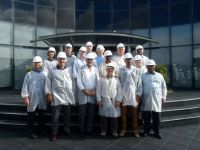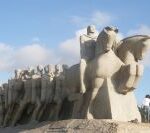May 11, 2014 bom dia from Sao Paulo
 Just before I left Bloomington, my son David said,”Dad, you’ve never been to Brazil, Argentina, and Chile. I expect I’ll be reading a lot from the Lonely Planet.” I want to assure him that I don’t have a copy of that standby, so what follows are sleepy observations over 6,000 miles south of Bloomington Normal.
Just before I left Bloomington, my son David said,”Dad, you’ve never been to Brazil, Argentina, and Chile. I expect I’ll be reading a lot from the Lonely Planet.” I want to assure him that I don’t have a copy of that standby, so what follows are sleepy observations over 6,000 miles south of Bloomington Normal.
I’d like to say it’s an easier flight than Asia, and it certainly is shorter—by about 3-4 hours. In addition, the time zone change is only 2 hours (it’s two hours later in Sao Paulo than in Bloomington, lying south but also East). But David is right: it is a new experience for me.
I can sort of thank the Pope that I’m in a Portuguese-speaking country. Early in the age of exploration, he divided the world between his two major Catholic countries—Spain and Portugal—and what is now Brazil fell into the Portuguese partition. That’s made the Portuguese language one of the most popular in the world because Brazil’s population is nearly 200 million, surprisingly overwhelmingly urban. I think the figure I saw was 85%, with Sao Paulo at around 12 million, and the more famous—and once capital city, Rio de Janeiro, around 6 million.
Sao Paulo owes its founding nearly 460 years ago to the Jesuits, who came to convert the Indians. One byproduct was that the fields and mines that fueled the growth of Brazil (this was the age of mercantilism, when colonies existed to enrich the mother country) were staffed by African slaves, adding to what proudly has emerged as a multinational society. Sao Paulo has Jewish, German, Japanese (yes, there’s a Japantown, but not a Chinatown) areas, among others. In return for the language and the religion, Brazil made Portugal richer; Lisbon suffered a major earthquake in the middle of the 18th century, and it was rebuilt in Baroque style, made more baroque by the import of gold from Brazil. The churches in Lisbon are incredibly gilded!
Ironically, it was gold that led Brazil to declare independence from Portugal. During the French Revolution, the royal family fled Portugal to settle in Brazil when Napoleon took over the Iberian Peninsula. Apparently, when the King returned to Portugal, his son remained as Emperor of Brazil. Son apparently got annoyed when dad raided Brazilian gold to pay debts to Britain (the Brits should have settled for port wine, I think), and declared independence from Portugal.
Sao Paulo owes its prominence initially to agriculture. There’s not much left from 450 years ago (the churches, though, are quite classic; the main Cathedral, the Se, is supposed to resemble Notre Dame in Paris), but there were some nice mansions once owned by coffee barons. Brazil is one of the leading countries of the world in coffee production, which we savored at a local non-Starbucks stop on our tour of the city. It’s also a major producer of sugarcane—and ethanol—which has led to a number of auto plants located in the Sao Paulo area, partly because the car engines need to be adapted to burn the “cleaner” ethanol fuel (ethanol from corn is expensive because the corn needs to be converted to the sugar that comes from sugar cane).

It is fall here, and getting cooler; which means the large homeless population is camping in the public parks. There were a few squares downtown that I would love to have explored, but our guide exercised caution and kept us on the bus. It will be interesting to follow the world’s greatest sporting event—as the World Cup is (probably accurately, except in the United States) billed here, given the cost overruns and deadlines for facilities that might not be met, which begins in 33 days. I’m glad we’ll be gone by then. Someone said there are 8 million cars on the streets of Sao Paulo, but the government will probably do something like Beijing did (license plates dictated when people could drive); we may get a sense of the potential nightmare when we start our serious visits tomorrow.
I hope you all had a wonderful mothers’ day. It’s celebrated here, too.